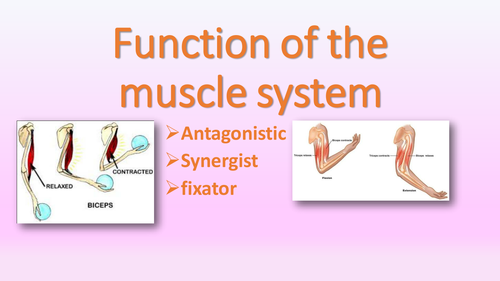























This item is a resource package, which consists of a 25 page interactive student booklet for the BTEC Health and Social Care Level 3 Unit 3 Anatomy and Physiology B5 Muscular System AND B7 Nervous System. Ypu can add to or alter the booklet to suit your own teaching style.
Along with this, is the fourteen engaging PowerPoints and additional work sheet tasks, card match activities and exam questions, that go with it, as well as a dice rolling fun revision game for students to identify areas they do not yet fully understand.
PowerPoints are well designed and have embedded videos in them, with booklet pages for students to make notes and example of possible exam questions that may be asked. Included is an exam paper covering just this topic to check progress with an easy to understand mark scheme for optional peer marking to save on your time.
B5. The structure, function and main disorders of the muscular system
• The structure of striated muscle
• How muscles are attached to the body: tendons, fascia.
• Types of contraction: isometric, concentric, eccentric.
• Function of the muscular system: movement – antagonistic pairs (agonist, antagonist), synergist, fixator.
Location and action of major muscles, to include:-
erector spinae, rectus abdominis, internal and external obliques, biceps brachii, triceps brachii, deltoids, pectoralis major, trapezius, latissimus dorsi, gluteus maximus, semimembranosus, semitendinosus, biceps femoris, adductors, rectus femoris, vastus lateralis, vastus medialis, vastus intermedius, tibialis anterior, gastrocnemius, soleus.
Diagnostic technique
A dysfunction of the muscular system
• muscular dystrophy
B7. The structure, function and main disorders of the nervous system
• The central nervous system (CNS)
• The structure and function of the brain and spinal cord
• Co-ordination of both voluntary and involuntary activities of the body.
• The peripheral nervous system – motor neurones, sensory neurones, nerve cells.
• The parasympathetic nervous system and sympathetic nervous system.
• Conduction of nerve impulses to and from the CNS; passage of a nerve
Diagnostic techniques
• Evoked Visual Response testing for optic nerve myelin sheath damage
• Lumbar puncture
Dysfunctions of the nervous system
• Parkinson’s disease
• Multiple Sclerosis (MS),
• Dementia.
I have other booklets and resource packages to cover the whole Unit 3 Anatomy and Physiology spec, add me as a favourite on TES and my other resources will be in one place and there will be notifications when I add new resources too =
There’s a Facebook group with 5,000 health and social care sharing ideas and resources, come and join the big subject team :-)
#hscresources
Something went wrong, please try again later.
Great resources, thank you.
Fab thanks
Report this resourceto let us know if it violates our terms and conditions.
Our customer service team will review your report and will be in touch.